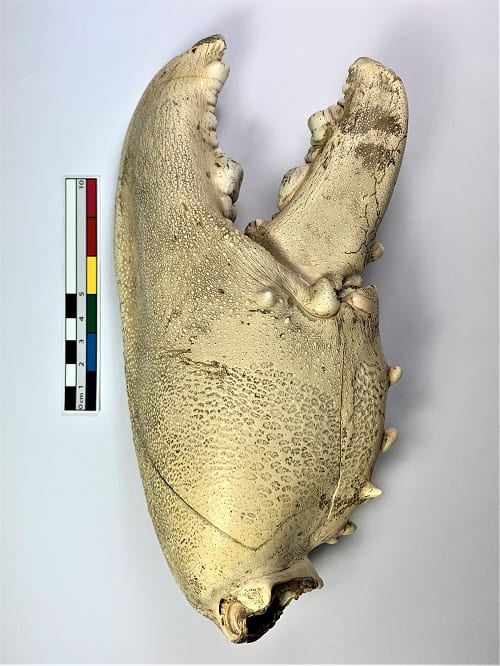Specimen of the Week 377: The Lobster Claw
By Graham Isted, on 15 March 2019
Hello and welcome to the next instalment of Specimen of the Week. This week’s specimen is a mighty claw (LDUCZ-H671) from the lobster species Homarus gammarus, also known as the European or common lobster. Lobsters are great, whether you like them to be freely going about their lives at the bottom of the sea or perhaps prepared by a chef on a dish with some butter. Either way, I am fairly certain there are aspects of their lives you are unaware of and this blog will hopefully either make you hungry for more knowledge or perhaps just dinner.
These shy nocturnal marine creatures live in shallow water (approx. 20-150m depth) walking on compacted mud, reefs or rocky areas.

IUCN Redlist Website image showing distribution of the predominantly coastal species H. gammarus (Ref: Cropped image from www.iucnredlist.org/species/169955/69905303)
Body matters
Lobsters belong to the invertebrate subphylum Crustacea. This huge group of animals includes marine animals like crabs, shrimp and barnacles as well as terrestrial crustaceans like woodlice. Lobsters have 10 limbs, including two specialised large claws. Males and females both have one large blunt claw used for crushing whilst the other is more slender, sharp and used for slicing. This week’s Specimen of the Week is a crushing claw. Lobsters have a rigid exoskeleton which protects the soft tissues of their body. Pumping around the lobster’s body is transparent blood, unlike our red blood cells. Lobster’s shells are not naturally red – they turn red when cooked. European lobster are naturally a dark blue/maroon colour with yellowish spots.
The long and the short of it
You’re perhaps wondering, how did this claw end up in our collection? Did someone in the past find a dead lobster/or kill a lobster and removed its claw? Well, not necessarily. This lobster might in fact still be alive! No, this is not some sort of undead zombie claw (‘Walking Dead’ style). When a lobster is in a growing phase (this happens continuously throughout their lives) they moult their hard-shell in order to grow a new larger one each time (on average approximately 50% bigger in volume). They are referred to as a soft-shelled lobster until their new shell hardens. Lobsters have an exceptional appetite after moulting, resulting in them often eating their own recently emptied shells. This meal provides a great source of calcium which helps to speed up the hardening of their new shell. This species of lobsters can grow up to 1.26m long, weigh as much as 9.3kg and live as long as 100 years. Furthermore lobsters are known to be able to grow back limbs, over several moults. So in theory this lobster could still be out there, ‘alive and kicking’ and ‘fully armed’!
When it comes to lobster fishermen, size does matter. There are regulations in place which mean these fishermen throw back any lobsters that are too small or too big. Small ones need more time to grow, while the largest ones are needed for their genetic material.
For a species that can live so long and grow so large they have remarkably small brains. Lobster’s brains are approximately the size of the tip of a ball-point pen. They have poor eyesight, though highly developed sensors for smell and taste.
Not such a fancy dish?
Lobster is generally considered a premium-priced meal in a restaurant, however this has not always been the case. Lobsters were once considered ‘the poor man’s chicken’ and so were only eaten by the poorest members of society, used as fertiliser or feed to livestock. Lobsters have a high amount of protein, omega-3 fatty acids and are low fat. Additionally, some people believe lobster is an aphrodisiac, but we shall leave that for you to research to your heart’s content.
Lobster love – coming out of one’s shell
Lobsters continue to grow and reproduce throughout their lives. Reproduction is instigated by the female, who having reached sexual maturity at 5-8 years old, sends out a pheromone which attracts males when she has moulted. Females can produce 5,000-40,000 eggs. Females are not monogamous and so offspring can be from multiple fathers. Once fertilised the eggs develop within the female for a year. Afterwards, the fertilised eggs are carried under the tail of the female for up to a year until they hatch.
You look quite tasty
Lobsters typically feed on clams, snails, crabs, sea urchins, worms, starfish and sometimes fish and plants. When food is limited lobsters may eat smaller lobsters. As mentioned before, lobsters are at their most vulnerable when they have moulted, however when the female releases their pheromones the males typically only have one thing in mind. Other than hungry cannibalistic lobsters, their other predators include cod and octopus.

LDUCZ-H671 (aka The Claw) waving a fond farewell accompanied by some of his fan base from the Toy Story film set
References
Barrie, J. 2017. lobster to sushi: foods of the poor that became luxury items. The Telegraph, Life Style, Food and Drink. Last accessed on 11th March 2019 www.telegraph.co.uk/food-and-drink/features/from-lobster-to-sushi-foods-of-the-poor-that-became-luxury-items/
O’Dwyer, F., Dr Nolan, C., Nee, D., O’Donovan, V., Parke N., Boyle A, Flannery, A., and Dallaghan, B. 2007. European Lobster (Homarus gammarus) Handling and Quality Guide. BIM Ireland’s Seafood Development Agency. Last accessed on 9th March 2019: www.bim.ie/media/bim/content/downloads/BIM,Lobster,Handling,and,Quality,Guide.pdf
Meeren, G. 2013. European lobster. Institute of Marine Research. Last accessed on 9th March 2019.https://www.hi.no/temasider/skalldyr/hummer/europeisk_hummer/en
Prodöhl, P. A., Jørstad, K. E., Triantafyllidis, A., Katsares, V., and Triantaphyllidis C., 2007. European lobster – Homarus gammarus. Genimpact Final Scientific Report. Accessed on 9th March 2019: www.imr.no/genimpact/filarkiv/2007/07/european_lobster.pdf/en
Unnamed author. 2017. Biology of the European lobster, Homarus gammarus. The National Lobster Hatchery. Last accessed on 9th March 2019. www.nationallobsterhatchery.co.uk/whats-it-all-about/education/lobster-biology/.
Unnamed author. 2018. European lobster. Scottish Government Riaghaltas na h-Alba gov.scot. Last accessed on 9th March 2019: www2.gov.scot/Topics/marine/marine-environment/species/fish/shellfish/ EuropeanLobsterBiology.
 Close
Close



